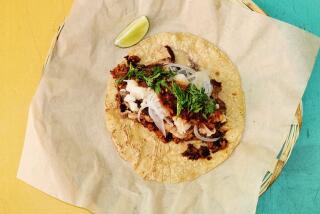The Elements of Tamales
- Share via
Banana Leaves: Used in some parts of Mexico and in Central America. Choose the freshest leaves you can find; avoid coarser, darker leaves. To prepare for filling, lay the leaf flat and cut down each side of the hard center rib, beginning at the top of the leaf and cutting with the grain (cutting from the bottom can tear the leaf). Discard the rib, then cut the leaf into the required sizes. To give leaves enough flexibility to wrap a tamale, wilt them over a gas flame or hot electric burner by passing the leaf slowly over the heat source. Color and texture will change after about four to six seconds on each side. To prevent leaf from burning, keep it moving.
Corn Husks: Thin, pliable husks need be immersed only a few moments in water, shaken dry, then used. Tough, brittle husks should be soaked in warm or boiling water at least 15 minutes and up to an hour, then shaken or patted dry on a thick towel. Stack soaked husks overlapping so they can be separated easily when it’s time to fill them.
Corn husk ties for tamales can be made by stripping the husks into narrow strands, then soaking them for 10 minutes to give them greater strength and flexibility. If you buy corn husks from a non-food source, like a craft store, be sure they are untreated and safe to eat.
The filling sticks better to the husk when the masa is placed on the ridged side of the husk, but the husks are easier to fold when the masa is spread on the smooth side.
Fresh Masa (Masa Refregada, Masa Molida): Tortillerias and many tamale makers often sell fresh masa to cooks--as long as they’re not competitors. The corn has been cooked with slaked lime, then coarsely ground. As opposed to masa preparada, nothing else has been added; you still need to add the lard or fat of your choice. To make vegetarian tamales, buy fresh masa and add vegetable shortening in place of lard.
Masa Flour (Masa Harina): It means “flour for masa” and it’s made of coarse-ground dried masa. To use it, you must reconstitute it with water or stock and then beat in the fat of your choice.
Prepared Masa (Masa Preparada): This is fresh masa that has been mixed with lard and is ready to be smeared on a corn husk. Many cooks prefer to add the lard themselves to get the lightest texture possible, but if you have a reliable source for masa preparada, it is an acceptable shortcut.
Lime (Cal): Calcium oxide, or chemically pure lime, is often sold by the pound in rock-like pieces and must be liberally sprinkled with cold water to activate the slaking process. As it slakes, the lime will sizzle and throw off vapors as it dissolves. Once slaked, the liquid should taste bitter. If you buy powdered lime that has already been slaked, it can be used as is in recipes. For safety, keep the lime away from your eyes and use a noncorrodible container to dilute it.
Nixtamal: Buy this if you want to grind your own corn, but you don’t want to bother with the lime; the corn kernels have already been cooked in a lime-water solution. Occasionally, ground, fresh masa refregada is labeled nixtamal as well.
Dried Hominy or White Corn: If you’re truly starting from scratch, you’ll start with dried whole corn kernels. Be sure that the corn you buy is not marred by hungry insects; if the corn is packaged, look for a powdery residue at the bottom of the bag which could indicate infestation. Also avoid corn that has a musty odor.
* Sources: “The Art of Mexican Cooking” by Diana Kennedy (Bantam) and “Food From My Heart” by Zarela Martinez (Macmillan).


